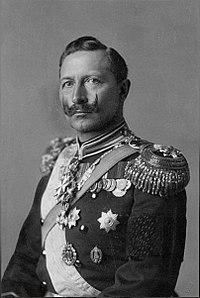
Back أباطرة ألمانيا Arabic Германскі імператар BE Германски император Bulgarian Německý císař Czech Tysk kejser (Tyske Kejserrige) Danish Deutscher Kaiser German Γερμανός Αυτοκράτορας Greek Germana Imperiestro EO Emperador alemán Spanish Saksa keiser ET
| Emperor of the German Empire | |
|---|---|
| Deutscher Kaiser | |
Imperial | |
 | |
 | |
| Details | |
| Style | His Imperial Majesty |
| First monarch | Wilhelm I |
| Last monarch | Wilhelm II |
| Formation | 1 January 1871 |
| Abolition | 28 November 1918 |
| Residence | Berlin Palace
|
| Appointer | Hereditary |
| Pretender(s) | Georg Friedrich |
The German Emperor (German: Deutscher Kaiser, pronounced [ˈdɔʏtʃɐ ˈkaɪzɐ] ⓘ) was the official title of the head of state and hereditary ruler of the German Empire. A specifically chosen term, it was introduced with the 1 January 1871 constitution and lasted until the abdication of Wilhelm II was announced on 9 November 1918. The Holy Roman Emperor is sometimes also called "German Emperor" when the historical context is clear, as derived from the Holy Roman Empire's official name of "Holy Roman Empire of the German Nation" from 1512.
Following the revolution of 1918, the head of state was the president of the Reich (German: Reichspräsident), beginning with Friedrich Ebert.